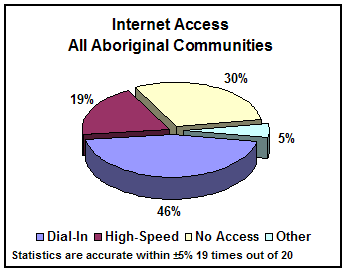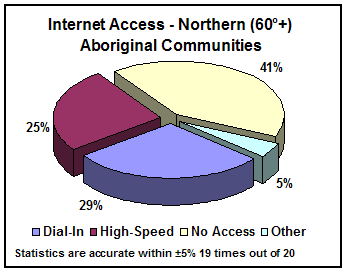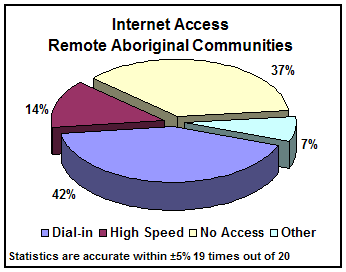Liens de la barre de menu commune / Common menu bar links
ᑐᓴᕋᑦᓴᖅ
ᓄᓇᖅᑲᖅᑳᖅᓯᒪᔪᑦ ᑲᓇᑕᒥ ᑐᓴᐅᑎᖃᕐᕕᖓᑦ ᒪᑐᓂᐊᓕᕐᒪᑦ ᕕᕗᐊᕆ 12, 2013. ᐊᑏ ᖃᐅᔨᒋᐊᕐᓗᑎᑦ ᐅᐸᒃᓗᒍ ᖃᕆᓴᐅᔭᖃᕐᕕᒃ ᑐᑭᓯᒋᐊᑲᓐᓂᕐᕕᒋᓗᒍ.
EXECUTIVE SUMMARYToday the Internet, the World Wide Web, has become a public, cooperative, and self-sustaining facility that is accessible to hundreds of millions of people worldwide. For Canadians, the Internet provides the means to access up-to-date information and receive fast service in all aspects of economic and social life. Increasingly Canadians are relying on the Internet as a tool for improving their access to education, healthcare, economic development, as well as other government and personal services. Connecting Canadian communities to the Internet with reliable high-speed Internet access will have a profound effect on virtually all aspects of resident lives. However; the communities that serve to benefit the most from the Internet are also the most difficult and costly to connect.It is not a surprise, then, that individual Canadians and businesses are looking for governments to move services on-line and assist with the deployment of information communications technology Infrastructure. Over the past few years great strides have been made to increase the level of connectivity in remote communities. Current service improvement plans, proposed government projects, and the trend analysis from our connectivity surveys lead us to believe that this will continue for the foreseeable future.  The purpose of this report is to track the trends in Internet connectivity in the Aboriginal communities of Canada. It is intended to address the need for information from Aboriginal communities as well as public sector policy and decision-makers. As fast as new technologies and applications are availing themselves to the Internet so are the upgrades to communication systems across Canada. Thus, it is very difficult to capture and present timely information on telecommunications infrastructure. We have assembled a composite picture of the telecommunications infrastructure in Aboriginal communities by joining our own community connectivity survey with data provided to us by major government connectivity programs. This is an analysis of telecommunications infrastructure and not Internet subscription rates. The purpose of this report is to track the trends in Internet connectivity in the Aboriginal communities of Canada. It is intended to address the need for information from Aboriginal communities as well as public sector policy and decision-makers. As fast as new technologies and applications are availing themselves to the Internet so are the upgrades to communication systems across Canada. Thus, it is very difficult to capture and present timely information on telecommunications infrastructure. We have assembled a composite picture of the telecommunications infrastructure in Aboriginal communities by joining our own community connectivity survey with data provided to us by major government connectivity programs. This is an analysis of telecommunications infrastructure and not Internet subscription rates.The above graph illustrates the level of connectivity in all communities. Based on the connectivity survey results, of the 737 Aboriginal communities:
NOTE: For the purpose of this report we consider those communities that incur long distance charges for their dial-in services as being disconnected. Most practical Internet applications like education, research, and healthcare are not feasible when on-line time is limited by long distance telephone charges.
 Moving north of 60°, we can see the effect that the Connect Yukon initiative has had on northern high-speed access rates. The availability of high speed Internet services in the north is 25%; greater than Canada as a whole. Communities with no acceptable access however increase substantially to 41%. Moving north of 60°, we can see the effect that the Connect Yukon initiative has had on northern high-speed access rates. The availability of high speed Internet services in the north is 25%; greater than Canada as a whole. Communities with no acceptable access however increase substantially to 41%.We have identified 83 Aboriginal communities north of 60°; 43 First Nations and 40 Inuit communities.  Looking closely at remote¹ communities (generally north of 55°, and/or over 50km from nearest service centre, and/or having no year round road access) we see that high-speed Internet access rates are at 14% while no acceptable connectivity remains high at 37%. Looking closely at remote¹ communities (generally north of 55°, and/or over 50km from nearest service centre, and/or having no year round road access) we see that high-speed Internet access rates are at 14% while no acceptable connectivity remains high at 37%.406 Aboriginal communities fit our definition of remote. This is comprised of 342 First Nations, 51 Inuit, and 13 Métis communities. The existence of an Aboriginal/Non-Aboriginal digital divide appears to be a function of urban vs. rural/remote infrastructure. With the average Aboriginal community having a population of less than 650, it is not surprising that Internet connectivity rates are low. It is interesting to compare the level of Internet connectivity available to Aboriginal communities with the overall Canadian population. While the Canadian Radio-television and Telecommunications Commission reports that 85%² of Canadians live in communities that are served by high-speed Internet services our research has shown that only 123,247 or approximately 25% of total in-community Aboriginal population has such service. Similarly, 24%³ of Canadian communities have access to high-speed Internet services. Our connectivity survey has identified 19% of Aboriginal communities having access to high-speed Internet services. All major urban centres in Canada have access to high-speed Internet services. We also know that 51% of the Aboriginal population now resides in urban centres. Thus, one could conclude that the majority of Aboriginal citizens have access to high speed Internet services. Unfortunately, the economic situation facing most urban Aboriginals severely limits their ability to subscribe to Internet services and purchase the required computer equipment. For many, the only means of accessing the Internet is through the network of 116 Native friendships centres. Although we did not directly contact the friendship centres, we do know that 87% of friendship centres are located within cities that have high-speed Internet available to them. We also know that 11% of friendship centres are co-located with Industry Canada Community Access Points. As stated previously, this is an analysis of the ICT Infrastructure in the Aboriginal communities of Canada. Although lack of appropriate infrastructure is the greatest impediment to Internet usage, mere exposure to a technology does not guarantee successful adoption. Additional considerations including access to computers, training, technical support, application development, and funding for ongoing monthly expenditures must also be made. Without it, the anticipated benefits for community members will be constrained due to unequal implementation and under utilization of the technologies. As demand for Internet services increase and costs for supplying these services decrease, we will continue to see smaller communities being connected. However, for some of the more remote and northern communities a viable business case may never be made for the extension of Internet services. For these communities the only hope for Internet connectivity lies in the aggregation of demand or cost subsidization. It is our hope that this report will help shape the development of a solution. In addition to preparing next year's report the Aboriginal Canada Portal will continue to track trends in Aboriginal community connectivity via our Web site: http://www.aboriginalcanada.gc.ca/connectivity in an attempt to provide the most current picture of these trends to those concerned. ¹ For the definition of a remote community, please see the section entitiled, vi. Defining Remote and Northern Communities, under Introduction b. Assumptions.
² Status of Competition in Canadian Telecommunications Markets- CRTC 2003. ³ Bridging the Digital Divide: The Canadian Experience - Presentation by Michael Binder (Industry Canada) to ICT4D, Oct. 14, 2003 |
